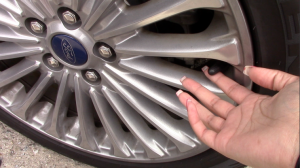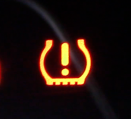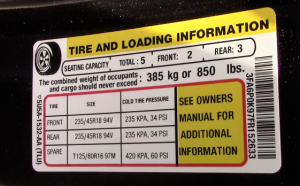Instead, why don’t we check our car’s tire pressure?
Hey guys! Welcome to our third installment of our “Car Maintenance” series! This week’s post is all about tire pressure. What does tire pressure tell us? How can we check it?? What if it’s too high or too low?! Now, don’t sweat it; this is actually a fairly simple task. It’s something you can either do yourself (hello again, DIY guys), or take into a shop/mechanic. Correct tire pressure has many benefits for you and your car: better fuel efficiency (save $$$ on gas!), longer tire wear, better handling, etc. Sounds good so far, right? So without further ado, let’s delve a bit further.
Feelin’ The Heat – Checking Tire Pressure
Before checking your tire pressure, make sure your tires are not “feelin’ the heat” – in other words, make sure they’re cold. An ideal time to check your tire pressure would be in the morning, or after your car has been idling for a few hours. This is because when your tires are at a hotter temperature, it may cause an inaccurate PSI (pounds per square inch) reading. The PSI reading, by the way, simply lets us know how many pounds of air are in our tires, signifying whether they need more or less air. To determine the correct PSI for your tires, consult either your handy-dandy owner’s manual, or check to see if there’s a sticker on the driver’s side door. This sticker will look a little something like this:
Generally speaking, smaller vehicles have smaller PSIs (around 30-40) whereas heavier cars need more PSI.
With all this being said, let’s get into the actual act of checking your tire pressure!
Like I mentioned earlier, you can take your car into a shop for this. I would suggest looking around for places that will check your tire pressure for free; such places do exist! But if you’re a “do it yourself” kind of person, this is something totally doable.
The first thing you’ll need is a tire gauge. You can get one for about $5, or $15+ if you’d rather have a digital one. And you can find these at pretty much any place that sells auto parts. (I got mine at a gas station!)
- Start by locating the valve stem on your tire and unscrewing the cap. (Remember: righty-tighty & lefty-loosey!) The cap should look something like the picture here:

- Insert your tire gauge into the opening. If you have a non-digital tire gauge, push it into the valve stem opening and a little measuring stick should pop out from the bottom. The measuring stick will give you your PSI reading. For digital gauges, a number will simply pop up on the screen.
- Repeat for each tire. (Pssst, spare a minute to check the spare tire, too!) Of course, don’t forget to screw the valve stem caps back on.
And… that’s pretty much all it takes to check your tire pressure! Not too bad, eh? Just keep in mind that there might be a PSI number on the tire itself, but this usually just signifies the maximum amount of air your tire can hold. You don’t want your tires over-inflated, so make sure to just check your owner’s manual or your tire label for the correct PSI for you.
So, how did your tires do? Hopefully they passed the PSI test. If your PSI is too low, then you run the risk of overheating your tires while driving, causing tread separation. Trust me, you do not want this to happen, as it is unsafe and could even cause an accident. On the other hand, if your tires have too much pressure, then less of your tires are touching the ground, making it more difficult to handle your car. You may also notice that your car bounces a lot more frequently, and the risk of popping your tires increases.
Procuring the Proper PSI
Were your tires under-inflated? Over-inflated? Either way, all hope is not lost! Both are relatively simple fixes. At a shop, they’ll be able to take care of it for you, though there may be cost involved. You could also easily do it yourself by buying a portable tire inflator, ranging in price from around $15 to $70+. If you have some under-inflated tires, simply fill ’em up with air until they are at the favorable PSI. Be careful that you don’t overdo it! Don’t have your own tire inflator? Many gas stations have air-filling stations for your convenience.
If you find one or more of your tires is over-inflated, then they need some air released. Using your gauge, you can push in on the open valve stem of your tire so that you hear a hissing sound. This is the sound of letting air out of your tires; just continue doing this until your tires reach the appropriate PSI. Again, careful not to let out too much.
Typically, cold weather will cause your tires to deflate, and warm weather will cause tires to inflate. Living in sunny Southern California, this probably means my dad should check to make sure his Volkswagen Beetle doesn’t have any over-inflated tires. Take your general weather into consideration when it comes to tire care.
TPMS?
 As you browse through our site, you may notice that some of our wheels will say “Does Not Accept TPMS,” “Accepts TPMS,” or “TPMS Not Included.” Here, we’ve covered what TPMS is; but it stands for Tire Pressure Monitoring System, and it reads your tire pressure for you. It may not give you the exact number, but it will alert you when one or more of your tires is under-inflated. The warning light will look something like the pic on the left.
As you browse through our site, you may notice that some of our wheels will say “Does Not Accept TPMS,” “Accepts TPMS,” or “TPMS Not Included.” Here, we’ve covered what TPMS is; but it stands for Tire Pressure Monitoring System, and it reads your tire pressure for you. It may not give you the exact number, but it will alert you when one or more of your tires is under-inflated. The warning light will look something like the pic on the left.
That’s a pretty handy feature, huh? Be sure to check out that TPMS article for more info, and don’t forget that we have all your OEM rim needs covered. And don’t worry – in most cases, your current TPMS will work on any replacement wheels you order from us unless otherwise stated.
Did I help alleviate some pressure? 🙂
– Kathy
OriginalWheels.com

